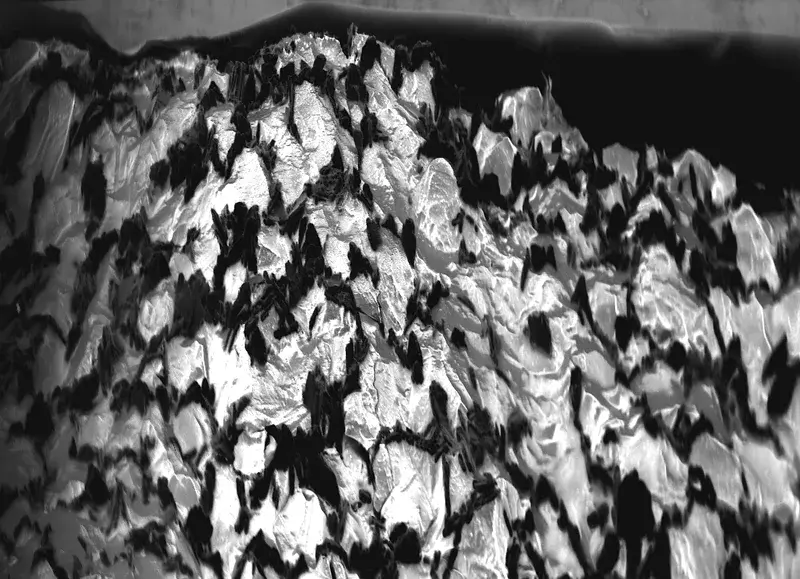
Blade's Edge "Iceberg"
by Sheng Fan, Geology Department, University of Otago, Dunedin, New Zealand
Presented the profile plane of an undeformed artificial two-phase ice. The two phase ice is fabricated from pure water ice and 10 vol.% of 75 micrometre graphite flake. The blade's edge shaped black pieces that stick out from the grey-white surface are graphite flakes. The grey-white "iceberg" is made up from ice crystals with the mean grain size of 400 µm. The graphite flakes interlock with ice crystals and align along the grain boundaries of ice and form such a stunning 5 mm high micro-landscape. We broke the 27 by 5 mm cylindrical sample from the middle perpendicular to the under surface and clamp it on a holder made from brass, to expose the profile plane for cryo-SEM scan. The sample and holder assembly was then placed on a cold stage that is attached in a Zeiss Sigma VP FEGSEM. The cold stage was maintained under -100 Celsius degrees at the variable pressure of 4 Pa by an external chamber filled with liquid nitrogen during the scan. The picture was taken as a variable pressure secondary electron (VPSE) image with the aperture of 120 µm and EHT of 15 kV.
Special thanks to Prof. David Prior and Dr. Marianne Negrini for the demonstrations and supports in the cryo-SEM operations. Thanks to the Otago Centre for Electron Microscopy (OCEM) for providing the equipment for the cryo-SEM scan.
Understanding the initial microstructure of two-phase ice is an important step of studying the creep behaviour of polar ice flow. The deformation process of natural ice responds to the alternation of temperature, strain rate and the participation of particulate second phase. The particulate second phase includes dust and rock fragments that are transported by atmospheric or sedimentary circulation and occupy approximately 1% of glacier ice by volume. The presence of very small concentrations of particles has been associated with large impacts on the dynamic of polar ice sheets. This project will focus on understanding the effects of particulate second phase on the ice creep history and seek for a quantification of its impact on the ice deformation mechanism from a series of new ice creep experiments conducted on two-phase ice and pure water ice.
Categories
Location
Tags
Colours
Image properties
5191 × 3756 px;
image/tiff; 19.0 MB
Camera:
Zeiss Zeiss Sigma VP FEGSEM
Software: Aztec, Oxford Instruments
Taken on 4
February
2018
Submitted on 4 February 2018
Licence
Creative Commons Attribution 3.0 Unported (CC BY 3.0)
Credit
Sheng Fan (distributed via imaggeo.egu.eu)
Share
Appreciate
Report